Gameplay
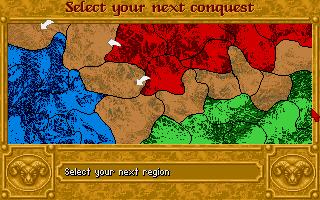 Territory Map
Territory Map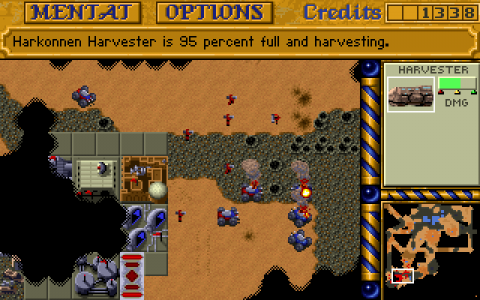 Gameplay
Gameplay
The player takes the role of a commander for one of the three Houses. Before each mission the player is presented a map of Arrakis on which the player can select the next territory to conquer. On almost all missions, the player gains control of a territory by completely obliterating the enemy.
During the missions the player is required to build up a base and an army in order to achieve victory. Any type of building in the game costs credits, and the player only starts off with a small amount of credits. To gain more credits, the player has to build Spice Refineries and collect Spice with a unit called the Harvester. There is a fixed amount of spice in each mission, forcing the player to be economical with the acquired credits.
The planet Arrakis is mostly covered with sand with a few patches of rocky terrain. The player is restricted to only build on the rocky terrain. Due to the harsh weather on Arrakis, all buildings will deteriorate and become in need of repair. Players can significantly slow down the rate buildings deteriorate, by covering the terrain with concrete slab before placing any structures on it. Arrakis also harbours giant sandworms, which can travel through sand and are capable of swallowing any land unit whole.
The game features fog of war, but unlike many modern RTS games, the fog once lifted is lifted forever.
DUNE (1992)
Duna 1992 — Компьютерная игра — квест с элементами стратегии
Именно французская компания Cryo Interactive Entertainment является первопроходцем, который перенес опасный пустынный мир с колоссальными залежами бесценного ресурса в компьютеры геймеров. Кроме того, именно она стала их первенцем.
Разработчики решили практически не отклонятся от сюжета первого романа и внесли в него лишь незначительные изменения. Поэтому главным героем стал молодой приемник герцога Атреидеса Пол Атреидес. Внешний вид большинства героев и NPC был взят с легендарной экранизации Линча и даже некоторые видео фрагменты фильма были вставлены в обновленное переиздание игры, которое появилось в 1993 году.
Сюжетная часть
В процессе создания Dune разработчики решили рискнуть и совместить в ней два жанра: квест и стратегию в реальном времени. Но при этом такое слияние было продумано интересно, грамотно и происходило постепенно. В самом начале сюжета главный герой постоянно перемещается по планете. Выполняет разного рода задания и старается привлечь на свою сторону как можно больше людей. При этом, ближе к концу уже всерьез приходится задуматься об обустройстве своей базы, добыче главного ресурса и создания собственной армии. Ведь нужно было уничтожить не только постоянного врага Дом Харконенн, но и успешно противостоять лучшим на планете войскам самого Императора.
Геймплей
Данную игру невозможно назвать простой. Геймеру постоянно нужно было держать равновесие между развитием экономики своего города и наймом войск. Агрессивная стратегия вначале может привести к тому, что спайса попросту не хватит для выплаты дани Императору. Предстояло также бояться и преждевременного нападения со стороны Дома Харконенн. А он по сюжету практически все время уверен в своем непоколебимом превосходстве.
Стоит отметить, что игра внесла значительный взнос не только в развитие RTS, но и в саму индустрию в общем. Это первая игра, которая распространялась с известными вкладышами для CD\DVD коробок. Изначально рисунки наносили непосредственно на лицевую сторону самой коробки, что значительно увеличивало ее цену.
На момент появления игра «Дюна» стала очень популярной и за 5 лет продаж ушла тиражом в 300 000 экземпляров. Но современное сообщество игроков о ней практически не слышало так как она столкнулась с довольно серьезным конкурентом.
Установка Дюна 2000
Перейдем к главному вопросу и разберем, как установить игру на компьютер. Все что от вас требуется — выполнить все шаги, приведенной ниже инструкции. Итак, переходим к делу:
- Скачиваем архив со стратегией. Для этого прокручиваем страничку вниз и в разделе «Скачать» кликаем по прямой ссылке, расположенной сразу под табличкой.
- Распаковываем архив и жмем двойным левым щелчком мышки по файлу с названием setup. На картинке ниже он обведен красным цветом.
- На следующем этапе выбираем папку, в которую будут распакованы файлы игры. По умолчанию стоит диск С. Чтобы выбрать другой, жмем кнопку «Обзор». После этого кликаем по «Далее».
- Ждем завершения инсталляции стратегии. В это время компьютер лучше не использовать и закрыть все сторонние программы.
- Для завершения инсталляции жмем кнопку «Завершить».
На рабочем столе ПК должен появиться ярлык, с помощью которого можно запускать игру. Для удобства можно закрепить стратегию на панели задач.
DUNE II: BATTLE FOR ARRAKIS (1992)
DUNE II: BATTLE FOR ARRAKIS (1992) — Легендарная компьютерная игра
Несмотря на то, что изначально правами на разработку игр вселенной Дюна владели исключительно французы, которые и создали первую Dune, представители издателя не были уверены, что молодая никому не известная компания будет способна создать что-то действительно стоящая. Из-за этого они исподтишка продали права еще одному уже довольно известному на тот момент разработчику Westwood Studios.
В то время как Cryo Interactive Entertainment создавали лорную версию игры. Вествуды взяли из книг самое сердце, а именно постоянное противостояние домов в попытке контролировать как можно больше залежей спайса. Такое решение само по себе означало, что в итоге должна получиться полноценная стратегия с незначительными вставками «лора» в виде брифингов персонажей перед каждым заданием.
Именно так и появилась на свет самая первая RTS в нынешнем понимании этого жанра. Для улучшения игрового процесса Вествудами довольно сильно был переиначен сюжет и добавлен еще один Дом Ордосов. Это превратило противостояние подполья и захватчиков в настоящее рубилово разных армий. Кочевники далекого космоса Фримены из игры не исчезли, но вместо основной огневой мощи Дома Атреидес они стали обычным вариантом юнитов для воспроизведения в казармах.
Таким образом игрок в DUNE 2 получает возможность выбора между партизанами Атреидесам, фанатами больших калибров Харконеннами и безбашенными диверсантами подрывниками Ордосами. Главной задачей игры стала постройка базы, создание как можно большего количества юнитов, постоянная добыча ценного ресурса и война за определенный участок планеты. К тому же время от времени приходиться неожиданно получать проблемы из-под земли в виде огромных червей Шаи-Хулудов. По мере успешно выполненных заданий игроку предоставлялся доступ к новым видам войск и улучшениям, а самой последней миссией была одновременная война сразу с двумя объединёнными домами и войсками Императора.
Игра Дюна, как она есть
В самом начале кампании разница в юнитах каждого дома заметна исключительно на визуальном уровне, но уже ближе к концовке, каждый из них постепенно раскрывает свою уникальность: особые постройки и уникальные боевые единицы. Таким образом, Атреидесы получали возможность нанимать фрименов, создавать звуковые танки и бомбардировать врага с помощью орнитоптеров.
В свою очередь Харконенны могли похвастаться супермощными танками с огромным уроном и возможностью запуска реактивных ракет на большие расстояния для бомбардировки вражеской базы или больших скоплений войск противника. При этом Ордосы получали «шахидов» для подрыва зданий и девиаторы (танки способные захватывать вражескую технику на определенный промежуток времени).
В момент выхода вторая Дюна являлась просто великолепной стратегией с отличными механиками, и если проанализировать ее сейчас, то можно выявить просто ошеломляющее количество разнообразных «фич». Так, например с помощью харвастеров и танков можно было с легкостью укатать в песок вражеских пехотинцев, а защита от воздушных атак осуществлялась только турелями. Еще можно было заничительно ускорить добычу ресурсов переправляя довольно медленные харвастеры между залежами и базой с помощью грузового самолета. Ну и наконец построенные без фундамента строения постоянно теряли свою прочность, что значительно уменьшало их эффективность.
Вместо заключения
Большинство геймплейных и визуальных черт второй Дюны продолжили свое существование не только в играх Вествудов (среди них легендарная серия Command & Conquer), но и других студий. При этом заложенный внешний вид с мини-картой и панелью задач определенного юнита до сих пор присутствует в классических RTS.
На протяжении 4 лет было распродано 250 000 дисков с игрой. Дюна 2 сразу же обросла огромным количеством положительных отзывов, средняя оценка которых в составляла 9 баллов из 10.
Антология Carmageddon (1997-2000) {L} [ENG]
Ребята из Stainless Software Ltd. создали один из самых кровавых шедевров за всю историю игр — Carmageddon! Конечно, он был не первый в своем роде так называемый »боевой автосимулятор». Вспомним хотя бы Death Rally, Distruction Derby, NICE и другие симуляторы. Но все это было что-то не то, чего-то не хватало. Все изменилось с выходом Ca …
Дата выхода: 1997-2000Жанр:Разработчик: Torus Games / Stainless SoftwareИздательство: Interplay Productions / Sales Curve InteractiveПлатформа: PCМинимальные: Pentium II 266 32 МбРекомендуемые: Pentium III 600 64 Мб Direct3D 7Тип издания: лицензияЯзык интерфейса: только английскийТаблэтка: не требуется
Акселератор.Лига смертников (1997)
Тебе не хватает острых ощущений? Ты истосковался по опасным приключениям? У тебя сердце замирает при мысли, что, сидя в гоночной машине стоимостью 1000000 долларов, можно заложить вираж на скорости 190 миль в час и при этом не вылететь за ограждение? Что ты сказал? Нет? Ты привык, что на маршруте размещается несколько заправочно-ремонтных …
Год выпуска: 1997Жанр: Arcade / Racing (Cars) / 3DРазработчик: SyneticИздательство: АмберСайт разработчика: http://www.synetic.de/Язык интерфейса: РусскийПлатформа: PC -Процессор Pentium 133 MHz -Оперативная память 16 Mb -Видеокарта c 2 Mb RAM -HDD 900 Mb -Windows: 95, 98, ХР (незабываем включать совместимость)
Units
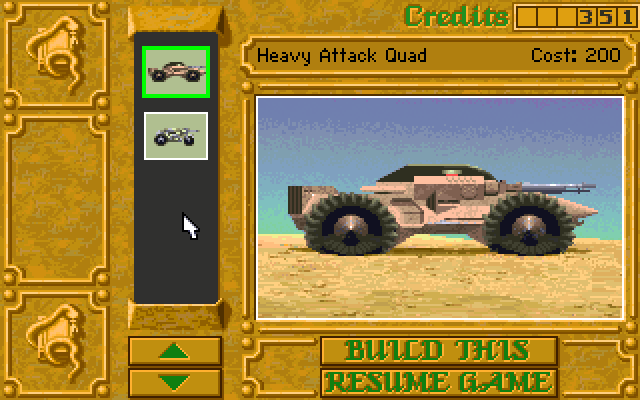 Heavy Attack Quad
Heavy Attack Quad MCV (Mobile Construction Vehicle)
MCV (Mobile Construction Vehicle)
- Harvester: Used to collect spice.
- MCV (Mobile Construction Vehicle): Can transform itself into a Construction Yard.
- Infantry: Lightly armoured foot soldiers
- Troopers: Soldiers armed with FS Rockets.
- Trike: Fast, lightly armoured vehicle.
- Quad: Lightly armoured vehicle. Slower, but stronger, than the Trike.
- Combat Tank: Medium armoured tank.
- Missile Tank: Tank which fires long range missiles.
- Siege Tank: Slow, heavily armoured tank with more than twice the firepower of the smaller Combat tank.
- Carryall: An airborne transporter
- Ornithopter: Lightly armoured aircraft capable of firing battle support rockets.
- Fremen: Arrakis natives allied with the Atreides.
- Sonic Tank: Atreides developed tank which fires powerful blasts of sonic energy.
- Deviator: An Ordos weapon which fires nerve gas capable of confusing enemies so they may temporarily change their loyalty.
- Raider: An Ordos modified Trike, with less armour, but more speed and manoeuvrability.
- Saboteur: Ordos espionage unit. Can destroy almost any structure or vehicle.
- Death Hand: A ballistic missile based at all Harkonnen Palaces. Can inflict great damage across a wide area.
- Devastator: Harkonnen Developed tank. It is the most powerful tank on Arrakis, and also very slow.
- Sardaukar: The Emperor’s elite troopers. They have superior firepower and armour to other infantry units.
Game principle and background
The history and concepts of the game based rather loosely on Frank Herbert’s novel Dune , visually David Lynch’s film adaptation and elements from the non- canonical considered Dune Encyclopedia (z. B. House Ordos).
The player has the opportunity to fight for control of the desert planet on behalf of three different so-called high houses . You can choose from the houses of the noble and the wicked , both of which are also known from the novel, as well as the house of the devious trader clan Ordos, which is only mentioned in passing in the Dune encyclopedia by Willis E. McNelly from 1984 . Once the player has decided on a house, his task is to build a base in various missions of a campaign (campaign) with increasing levels of difficulty, to collect (in the novels and films also called spice or melange ) and to raise an army. The game is won as soon as your house rules the entire planet.
Development history
Dune II — Battle for Arrakis was produced and distributed by Virgin Interactive in 1992 and developed by Westwood Studios .
According to Virgin Interactive Vice President Stephen Clarke-Willson, development of Dune II began in 1998 when the development of Cryo Interactive Entertainment’s adventure game Dune was about to be discontinued and he was given the task of figuring out what to do with the Dune license be. After reading the book Dune , he decided that from a playful point of view the challenge was fighting for control of the , so a resource-focused strategy game was a suitable idea. At this point, employee Graeme Devine (who later developed The 7th Guest ) showed everyone in the Virgin office the real-time strategy game forerunner Duke Two from 1989. They then contacted Westwood Studios and suggested it, a resource-focused Dune strategy game and to use Herzog Zwei as a source of inspiration. Since it later turned out that Cryo could finish the game, Westwood’s game was then released as Dune II .
Westwood Studios co-founder and Dune II producer Brett W. Sperry said the concept of Dune II began in 2008 when Virgin President Martin Alper approached him with the offer of a Dune license to develop a computer game with which Understanding that Cryos Dune would be canceled. Sperry said the inspiration for the Dune II game design came in part from Populous and the Eye of the Beholder . The most important impetus, however, was a discussion with Chuck Kroegel . The then vice president of Strategic Simulations claimed that the war game genre was on the decline. Sperry saw this as a personal challenge and tried to develop a modern war game with modern operating concepts. He also gave Herzog Zwei as inspiration, but the GUI of the Mac as a further important inspiration , which gave him the idea of designing a context-sensitive playing field that is primarily operated with the mouse. During development, it turned out that Cryo managed to get their game completed first, leading Virgin to release it as Dune and Westwood’s game as Dune II , despite Sperry’s protest at the decision. However, Westwood’s Dune II is mentioned in the credits of Dune : «DUNE II — Coming Soon».
The Ordos House is mentioned in the Expanded Universe of the Dune Encyclopedia by Willis E. McNelly as the High House, but not that it is a family of merchants from an ice planet. Westwood Studios also changed the coat of arms of the Ordos (two crossbones with ivy tendrils on a yellow background) in Dune II to that of the House Wallach also listed in the Dune Encyclopedia . The ram’s head coat of arms was also adopted from there for the Harkonnen, although it actually has a blue griffin as heraldic animal. The Atreides coat of arms was taken from this one to one.
After the original PC version, the game was released in 1993 and 1994 for the Amiga and Segas video game consoles Mega Drive . The game was sold under the title Dune II: The Building of a Dynasty on the American market and as Dune II: Battle for Arrakis or German Dune II: Battle for the desert planet in Europe and in the mega-drive version.
The last version of the game published by Westwood for the PC was 1.07, but it was not yet completely bug-free, which is why fans later made unofficial patches available.
successor
Dune II significantly influenced Westwood’s subsequent in-house development Command & Conquer . For C&C, for example, the Dune II concept of a single resource around which the power struggle revolves was directly adopted.
Direct successors to Dune II are Westwoods Dune 2000 from 1998, a remake of the original game principle and based on a further development of the Command & Conquer technique, and Emperor: Battle for Dune from 2001, the first in series history used. However, both games could not build on the success of Dune II . In 2001, Cryo Interactive Entertainment released the 3D action adventure Frank Herbert’s Dune for PC and PlayStation 2 , which is based on the the same name .
Legacy[edit]
Dune II is one of the most influential games in the real-time strategy genre. Though not every characteristic was unique, attributes such as fog of war, and the game’s model for resource-extraction, base creation, and military micromanagement became several standards upon which the RTS genre is based. Obvious influences of Dune II can be seen in numerous games, particularly in Westwood Studios’ own Command & Conquer series.
Chris Taylor stated that Dune II and Command & Conquer were a very strong inspiration, motivating him to leave Electronic Arts to create Total Annihilation.
Dune II was given several direct sequels: a Windows remake of this game was published in as Dune 2000, along with a PlayStation port in the same year. In , Emperor: Battle for Dune was published.
Story[edit]
Emperor Frederick IV of House Corrino is desperate for the harvesting of the valuable spice melange, only found on the planet Arrakis, to pay off all of his debt incurred on internecine wars with family members. To achieve this, he now offers the sole governorship of Arrakis to the House (huge nobleman family/cartel) which delivers the most spice for him out of House Atreides, Harkonnen and Ordos. War begins as deputations from all three Houses arrive on Arrakis.
The player is a military commander from a House of their choice. In the first few missions the objective is to successfully establish a base on an unoccupied territory of Arrakis, to harvest spice and defend against intruders. Later, when the three Houses divide Arrakis among them, the player has to assault and capture enemy territories. When the player dominates Arrakis on the world map, the two other enemy factions ally against their common enemy. The ultimate final showdown is the battle among the player’s House up against three enemy sides, among them Frederick’s forces the Sardaukar (an unplayable elite force whose heavy infantry are particularly powerful). The final cutscene is different for each House, in consonance with their very disparate worldviews.
Versions[edit]
Amiga version in-game.
Dune II was originally released for MS-DOS. It was one of the first games to support Roland Sound Canvas, and one of the first to play digital samples over a Soundblaster card. Unfortunately it did not support two sound devices, so the player only had the choice between digitized speech (which is helpful in gameplay, since approaching enemy units are announced) and better music.
In it was converted to Amiga and Mega Drive/Genesis. Two years later it was also brought to the Archimedes and Risc PC range of RISC OS computers.
The Mega Drive/Genesis port has fairly different building and unit graphics, a full-screen menu-less user interface suited for gamepad control, and no savegame support, relying on access codes for accessing each level. Other additions include a music test option and a tutorial that replaces the mentat screen.
The Amiga port is nearly identical in interface and gameplay to the PC version, with less detailed graphics and frequent disk swapping—the game fits in 5 disks. Savegames are stored in a specially formatted disk.
Factions
House Atreides
Has a long tradition of being fair and just administrators. Their people are hard working, peaceable, and with an unusual devotion to duty. They prefer to achieve their goals through diplomacy, although this will not be an option on Arrakis.
House Ordos
This House represents a cartel of wealthy families, all living on a frigid and ice-covered world. The Ordos produce no physical product of their own and rely solely upon their merchandising skills to survive. They have little conscience and have a long history of manipulation, sabotage, and terrorism. (House Ordos is not featured in the Dune novels)
House Harkonnen
A cruel and ruthless House. They have a long history of employing violence and fear to achieve their objectives. Status is not bestowed in House Harkonnen, it is taken. Meaning that a subordinate advances by killing his superior.
FRANK HERBERT’S DUNE (2001)
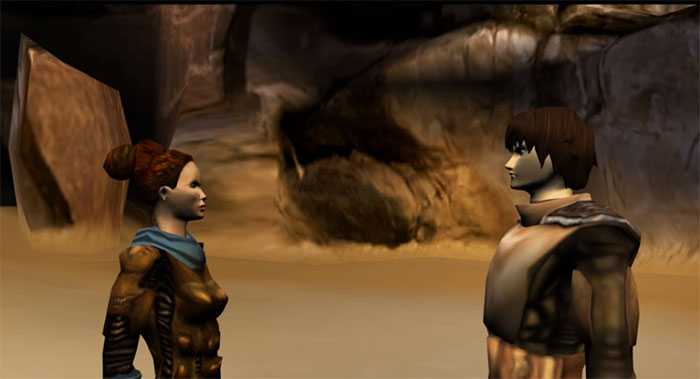 FRANK HERBERT’S DUNE (2001) — Единственный 3D-action во вселенной Дюны
FRANK HERBERT’S DUNE (2001) — Единственный 3D-action во вселенной Дюны
Почти одновременно с появлением «Императора» на экраны вышел небольшой сериал под названием «Дюна Фрэнка Герберта». Cryo Interactive решили попытаться выбраться из долговой ямы, создав игру по его мотивам.
К сожалению, практически полное банкротство не в лучшую сторону сказалось на качестве конечного продукта. Вместо ожидаемой интересной приключенческой игры со стелс режимом фанаты получили неудобоваримую смесь с отвратной графикой, постоянными зависаниями, кучей проблем и ужасно малым количеством геймплея. По понятным причинам игру практически никто не купил, а критики ставили оценки не выше 5/10.
Французы кинули все, что могли найти, на разработку игры и провалили ее с треском. Иронией в том, что первая Дюна принесла успех команде, а вот последняя стала последним гвоздем в крышку гроба. Cryo Interactive была признана полным банкротом и закрылась.
Passwords
Atreides Ordos Harkonnen
2 DIPLOMATIC DOMINATION DEMOLITION
3 SPICEDANCE SPICESABRE SPICESATYR
4 ETERNALSUN ARRAKISSUN BURNINGSUN
5 DEFTHUNTER COLDHUNTER DARKHUNTER
6 FAIRMENTAT WILYMENTAT EVILMENTAT
7 ASHLIKENNY SLYMELANIE ITSJOEBWAN
8 SONICBLAST STEALTHWAR DEVASTATOR
9 DUNERUNNER POWERCRUSH DEATHRULER
Other codes
The other codes should be entered during a pause in the game. The codes will be rejected as incorrect, but you will see the result in the game.
LOOKAROUND — open map;
SPLURGEOLA — 25,000 spice;
PLAYTESTER — immortality;
FASTMOVING — vehicles moves faster;
SUPERPOWER — the power of technology doubles.
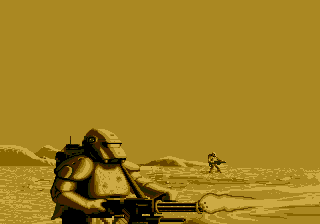

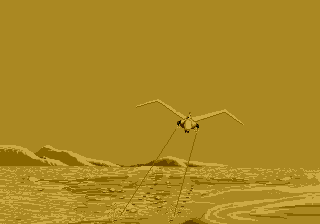
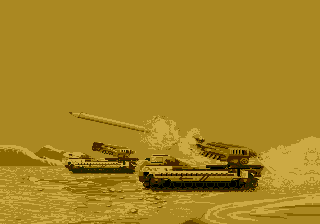
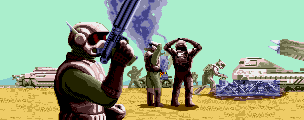
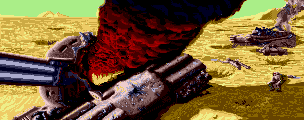
Legacy
Dune II is considered to be one of the most influential games in the real-time strategy genre. Its interface became the basis for subsequent real-time strategy games. In contrast to Herzog Zwei’s reliance on a commander unit, Dune II’s usage of the mouse for controlling base building and unit actions was completely new at the time.
Other features that carried over to many other games include:
- Resource-gathering to fund unit and building construction
- Construction dependencies (technology tree)
- Mobile units that can be deployed as Buildings
- Different sides/factions with unique unit-types.
- Destruction of enemy base as a goal
Artificial Intelligence[edit]
The AI of Dune II was one of the first used in real-time strategy games, and while better than that of Herzog Zwei, it has various drawbacks:
- It will only attack the side of the player’s base facing its base. Also, it targets a player’s building and will continually attack that target until it is destroyed. The AI targets the player’s repair center, palace, starport, and unit producing structures with high priority.
- It is generally incapable of flanking or ambush maneuvers. Only earlier versions of the game featured few ambushes, but they were preprogrammed on the level’s shape and not planned by the AI.
- It sends attacking units as soon as they are built from their base instead of assembling an attack force.
- It does not build additional defenses once initial base construction is concluded although the AI will replace destroyed base defenses as its priority.
- It will attack its own buildings in an attempt to get to your units which are within sight and firing range.
- It relies on several cheats, such as infinite credits, the ability to build unconnected buildings, and, on the 1.0 version, the ability to build structures on top of your units (which destroys those units in the process).
- If you surround its buildings with walls it will not try to destroy them and will get trapped.
- If you attack an enemy harvester with an infantry unit and let it retaliate (by squashing it), it’ll remain stopped and halt their spice production.
- If you select a deviated unit and click on attack, then wait until the deviator effect wears off, you can tell a then-enemy unit to attack anything without finding opposition.
Gameplay[edit]
The player takes the role of a commander of one of three interplanetary houses, the Atreides, the Harkonnen or the Ordos, with the objective of wresting control of Arrakis from the two other houses. The basic strategy in the game is to harvest spice from the treacherous sand dunes using a harvester vehicle, convert the spice into credits via a refinery and to build military units with these acquired credits in order to fend off and destroy the enemy. The game map initially starts with a fog of war covering all area which is not covered by the player’s units range of view. As the units explore the map, the darkness is removed. Unlike later games such as Warcraft II: Tides of Darkness, the fog of war is lifted forever with initial exploration, it does not become dark once more when units leave the area.
In addition to enemy incursions, there are other dangers; like the marauding and gigantic sandworm, capable of swallowing vehicles and infantry whole but only capable of moving through sand. The player can only build on rocky terrain, but must build concrete foundations before to avoid deterioration of the structures due to the harsh weather conditions although in general, structures will gradually decay over time regardless of the presence of those concrete slabs due to the aforesaid weather conditions. Spice fields are indicated by orange coloration on the sand, darker orange indicating high concentration. Some spice may be concealed as bumps on the terrain (a ‘pre-spice mass’) that become spice fields when they are shot at, or when a unit runs over them (the unit is destroyed in the ensuing ‘spice blow’).
The player is presented a map of the planet Arrakis before most missions, where he can choose the next territory to play in among two or three. This affects primarily the enemy house fought in the next mission, as all missions except the first two require the complete destruction of the enemy. Nine territories must be fought, irrespective of house, to reach the endgame.
Some key elements that first appeared in this game, but would later appear in many other RTS games, are:
- Mouse operated units and buildings
- A world map from which the next mission is chosen
- Resource-gathering to fund unit construction
- Simple base and unit construction
- Building construction dependencies (technology tree)
- Mobile units that can be deployed as Buildings
- Different sides/factions (the Houses), each with unique unit-types
- Destruction of the enemy as a goal
DUNE 2000 (1998)
DUNE 2000 (1998) — Компьютерная игра — продолжение легендарной серии
В конце 90-х Вествуды, благодаря разработке серии стратегий Command & Conquer, отлично держалась на плаву. А первопроходец Cryo Interactive Entertainment уже имел значительные финансовые трудности. Поэтому владельцы дали разрешение продолжить серию стратегий о «Дюне». К сожалению, плотная работа над «Генералами» не дала Westwood Studios возможности создать принципиально новую игру. Они предоставили работу новичкам из Intelligent Games, которые попросту решили выпустить ремейк уже существующей второй Дюны.
В конечном результате, фанатам пришлось довольствоваться абсолютно тем же сюжетом и незначительно измененным геймплеем. И преподносилось это в новой, более современной графической обертке. Все, что удалось добавить, это отличие урона разными юнитами друг по другу. Например, осадная техника отлично подходила для уничтожения зданий и пеших войск. А вот технику уничтожать ей было сложно. Классические бронированные единицы прекрасно расправлялись с себе подобными, а против пехоты были абсолютно бесполезны. Ну и, конечно же, в игру ввели совместный режим.
В средине 90-х такие изменения и принесли бы славу, но в то время это был провал. Игровые критики разнесли стратегию в пух и прах, поставив ей оценку в 6 из 10. А тираж дисков расходился очень плохо. И здесь, впервые, сработало знаменитое игровое проклятие «Дюны». Через некоторое время Westwood была выкуплена канадской EA.






![Dune 2000 (1998) [pc игры, старые игры] / скачать бесплатно](http://kokosclub.ru/wp-content/uploads/3/d/5/3d58a8e90d168423143334eb1997372e.jpeg)























